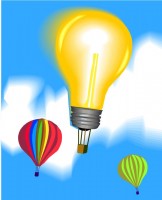Widgetized Section
Go to Admin » Appearance » Widgets » and move Gabfire Widget: Social into that MastheadOverlay zone
Light Bulb Moments in Experiential Learning
The views expressed are those of the author and do not necessarily reflect the views of ASPA as an organization.
By Angela Pool-Funai
May 15, 2015
Call me a little cynical, but I often chuckle when I hear fellow faculty members talk about using the Socratic Method in the classroom instead of simply saying they encourage questioning and discussion. Academia loves assigning names to anything and everything, doesn’t it? Sometimes, though, it becomes necessary to tweak the names of programs or projects in order to bring clarity to students and the community at large.
Take learning strategies, for example. Whether it is dubbed experiential, project-based, problem-based, inquiry-based (thank you, Socrates) or some other trendy moniker, the experience of the student is the crux of education. However, it should not stop at simply gaining knowledge or practice.
A non-traditional student might say that he or she has life experience and should not have to participate in the experiential learning course or program. In addition to attending school, many of these students work, have children, concurrently or previously served in the military or return to school after a period. They may expect that their accumulated experiences ought to take the place of an experiential learning curriculum. For these students and others like them, we need to be clear in our explanations and expectations.
An experiential learning environment encompasses more than life skills or familiarity with the world outside of academia. In order to glean the full benefits of experiential learning, students need to be guided beyond simply tactile or hands-on learning and delve into the “whys” of the matter.
Wage Gap Exercise
For instance, the topic of wage disparity between genders came up in a recent class. We discussed the historical aspects of the pay gap, including the Equal Pay Act and other accomplishments of the civil rights movement. We explored case law concerning workplace discrimination. We ventured into social media and blogs to find how-to articles for interviewing tips and contrasted the advice given to male and female candidates. We compared the pay gap between private and public sector professions.
All of those activities contributed to an interactive and interesting lesson, but we still didn’t have an answer to the question of why wage disparity still exists. Then, I paired up the class with mock scenarios where they needed to negotiate, either in an interview setting or as a current employee. (One person was the boss and the other an employee, and they switched roles with each scenario.) We recapped their experiences from the mock interviews as a class and talked about how in the real world, 57 percent of men negotiate their salaries, compared to a paltry 7 percent of women.
 The proverbial light bulbs started going off as students began making connections between negotiation practices and the gender wage gap. Even though organizations may follow the law concerning their hiring practices and offer equal base pay, if women do not negotiate with the same intensity as men, then they could feasibly begin identical positions with different salaries and/or other benefits, and the gap will continue to grow over time. This reflection and application exercise helped to solidify the experience of negotiating and guided the students to relate the lesson to their own lives – not only presently, but also in the future as they considered their career goals.
The proverbial light bulbs started going off as students began making connections between negotiation practices and the gender wage gap. Even though organizations may follow the law concerning their hiring practices and offer equal base pay, if women do not negotiate with the same intensity as men, then they could feasibly begin identical positions with different salaries and/or other benefits, and the gap will continue to grow over time. This reflection and application exercise helped to solidify the experience of negotiating and guided the students to relate the lesson to their own lives – not only presently, but also in the future as they considered their career goals.
Project-based Learning
The scenario provided represents a single classroom lesson. As we prepare graduates for the real world of public sector professions, I believe we should provide ample experiential learning opportunities. In addition to incorporating such learning strategies into existing courses, one area of focus that excites me as an instructor is project-based learning.
Undergraduate students at Southern Utah University (SUU), for example, participate in the EDGE program (Education Designed to Give Experience). They develop and implement a project over the course of their time at SUU and it culminates with a guided reflection over the experience and an opportunity to showcase the final project. Graduate students in the master of public administration program have the opportunity to conduct a professional project for course credit, where the program’s competency measures are tied closely to the project outcomes. Students do not simply submit project reports. They are expected to synthesize the objectives of the project with specific competency goals and their long-term career aspirations.
Like our students, we too are always learning. That is the beauty of experiential education. We learn and grow from our experiences. We apply that new found knowledge to improve our courses and programs and better prepare the future leaders of our society.
Author: Angela Pool-Funai is an assistant professor of political science and public administration at Southern Utah University. Opinions are her own. She encourages feedback and can be reached at [email protected].


 (5 votes, average: 4.80 out of 5)
(5 votes, average: 4.80 out of 5)
Follow Us!